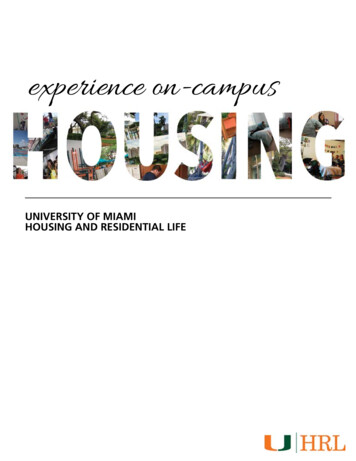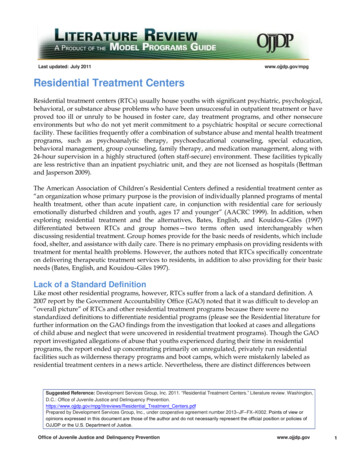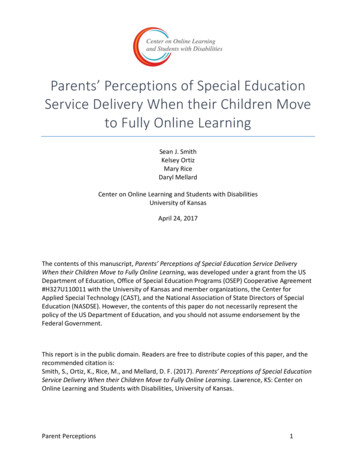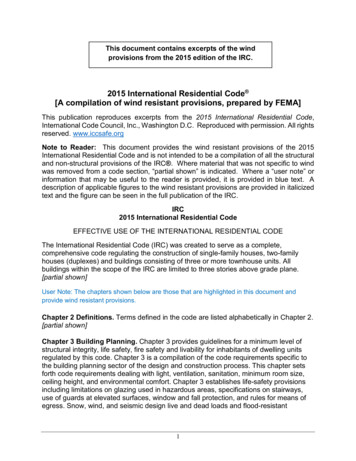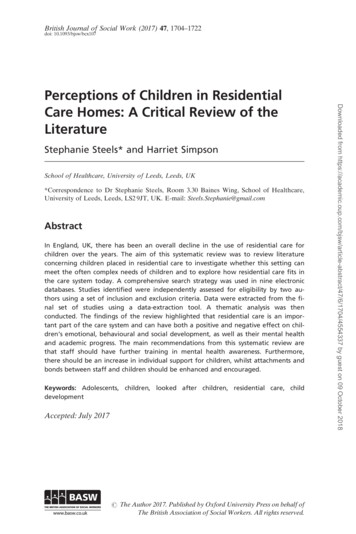
Transcription
British Journal of Social Work (2017) 47, 1704–1722doi: 10.1093/bjsw/bcx107Stephanie Steels* and Harriet SimpsonSchool of Healthcare, University of Leeds, Leeds, UK*Correspondence to Dr Stephanie Steels, Room 3.30 Baines Wing, School of Healthcare,University of Leeds, Leeds, LS2 9JT, UK. E-mail: Steels.Stephanie@gmail.comAbstractIn England, UK, there has been an overall decline in the use of residential care forchildren over the years. The aim of this systematic review was to review literatureconcerning children placed in residential care to investigate whether this setting canmeet the often complex needs of children and to explore how residential care fits inthe care system today. A comprehensive search strategy was used in nine electronicdatabases. Studies identified were independently assessed for eligibility by two authors using a set of inclusion and exclusion criteria. Data were extracted from the final set of studies using a data-extraction tool. A thematic analysis was thenconducted. The findings of the review highlighted that residential care is an important part of the care system and can have both a positive and negative effect on children’s emotional, behavioural and social development, as well as their mental healthand academic progress. The main recommendations from this systematic review arethat staff should have further training in mental health awareness. Furthermore,there should be an increase in individual support for children, whilst attachments andbonds between staff and children should be enhanced and encouraged.Keywords: Adolescents, children, looked after children, residential care, childdevelopmentAccepted: July 2017# The Author 2017. Published by Oxford University Press on behalf ofThe British Association of Social Workers. All rights reserved.Downloaded from 6/1704/4554337 by guest on 09 October 2018Perceptions of Children in ResidentialCare Homes: A Critical Review of theLiterature
Perceptions of Children in Residential Care Homes 1705IntroductionDownloaded from 6/1704/4554337 by guest on 09 October 2018Care planning is highlighted in recent UK government policy changes asan important feature of providing excellent care for children, with anemphasis on having an individual placement planning (Department forEducation, 2011). Furthermore, there is a focus on the individuality ofchildren and the need to observe their wishes and rights as individuals(Department for Education, 2011). The National Minimum Standardsfor Children’s Homes has also been an influential policy in regards toraising awareness of need for quality care in children residential carehomes (Berridge et al., 2012).Additionally, children in care are expected to pursue as normal a lifeas possible (Hart et al., 2015). However, due to the experiences theyhave had and the issues they are facing, ‘normality’ for most children incare may be an unachievable and unrealistic expectation. Furthermore,the role of the residential care worker is more challenging at presentcompared to their role in the past. These range from reduced resourcesto provide the same level of care, to scaled-down support from otherhealth and social care services (Berridge et al., 2012). In addition, therehas been a growing number of children with a range of mental health issues (such as self-harming behaviours), challenging behaviour and interpersonal problems entering residential care (Macdonald and Millen,2012; Andersson and Johansson, 2008). To care for children with complex needs, workers must have a good understanding of children’s needsand development (Department for Education, 2011), as well the child’sprevious circumstances, where they may have experienced abuse of neglect (Bettmann et al., 2015). However, it is widely known that few staffmembers working in residential care homes have the relevant qualifications for residential practice, may lack experience and cannot easily access training to further develop their knowledge and skills (Courtneyand Iwaniec, 2009).There is a growing view that family placements are better able tomeet children’s needs compared to residential homes (Berridge et al.,2012). Consequently, an increased number of children with challengingbehaviour, who would have been cared for in a residential care home inthe past, are now placed in foster-care (Biehal, 2007). This emphasis onplacing children in foster-care is concerning, as some children are fundamentally better suited to residential care. This may increase the risk offurther distress in children should they be placed in an unsuitableplacement.As a result, this article provides a critical systematic review of the literature on perceptions of children in residential care. It seeks to complement other research that has been completed on looked after children(LAC) from the perspective of the child (such as Berridge et al., 2012
1706 Stephanie Steels and Harriet SimpsonLAC in EnglandIn March 2016, there were 70,440 LAC in England (Department forEducation, 2016). Children are placed in care if they are experiencingabuse, neglect or other maltreatment (Taylor and Smith, 2006;Department for Education, 2016). Furthermore, children may be placedin care voluntarily if parents are struggling to cope with the demands ofparenting (Knowles and Holmstrom, 2013; NSPCC, 2016). Placement options for LAC include foster-care, children’s homes, secure children’shomes, hospital wards and residential schools (Davies, 2012). Residentialcare is a setting in which children are provided with care to encouragethem to develop physically, socially and emotionally, and to promotetheir health and well-being (Fulcher, 2001).The profile of children in England has changed, particularly over thelast four years. In 2016, 62 per cent of LAC were aged ten years andover compared with 56 per cent in 2012 (Department for Education,2016). This has been attributed to the increase in unaccompanied asylum-seeking children: 75 per cent are aged sixteen and over(Department for Education, 2016; Home Office, 2016). Whilst LAC arepredominantly white British (75 per cent), children of mixed ethnicityare the next largest group (9 per cent), followed by black British (7 percent), Asian or Asian British (4 per cent) and other ethnic minoritygroups (3 per cent). However, gender variations have varied little, with56 per cent of LAC male and 44 per cent of LAC female in 2016(Department for Education, 2016).There has been an overall decline in the use of residential care forchildren (Hart et al., 2015). In addition to the cost implications of residential care, it has been suggested that attitudes towards residential careas a placement of preference have changed, with apprehensions aboutDownloaded from 6/1704/4554337 by guest on 09 October 2018and Wigley et al., 2012). In particular, this article seeks to address thefollowing questions:1. What are the potential positive effects for children being placed ina residential care setting?2. What are the potential negative effects for children being placedin a residential care setting?The structure if this paper is as follows. First, the context of LAC inEngland is summarised. This is followed by the literature review methodology which details the study selection criteria, the search strategy,the selection process, data extraction, methodological quality and dataanalysis. Then, the key findings of the thematic analysis of the literatureare presented. Next, the results are discussed with reference to currentsocial work practice. Finally, our conclusions and recommendations forsocial work practice and future research are presented.
Perceptions of Children in Residential Care Homes 1707MethodologyThe PRISMA checklist was used to develop the systematic review protocol. A ‘mixed methods’ approach was used to allow both qualitative andquantitative studies to be included to maximise the range of studies thatDownloaded from 6/1704/4554337 by guest on 09 October 2018the absence of attachment in young children and the risk of abuse asreasons for other placement options to be considered first (Jacobs et al.,2012; Iwaniec, 2006).As a consequence, it has been suggested that residential care is mainlyused for children considered incapable of living in a family environmentand is therefore viewed as a ‘last resort’ (Rich, 2009). This is damaging,as it gives a negative message to society that only the ‘worst’ childrenlive in residential care. Children tend to have a series of unsuccessfulfoster placements before residential care is discussed by social services(Hart et al., 2015). It is important to note that, before being placed inresidential care, children may have experienced trauma, neglect, abandonment, mental health problems, have shown antisocial behaviour andoffending or have a serious medical condition (Macdonald and Millen,2012). These issues may contribute to the reasons why children mayhave unsuccessful foster placements.Attitudes that adults have today of what childhood comprises can becomplex and contradictory. Children are often seen as vulnerable and inneed of protection, yet also threatening and needing to be controlled(Bell, 2011). This view is very much potrayed throughout the UK caresystem, suggesting that there is confusion in whether children need controlling or protection, which can impact on the way in which residentialcare is managed. Arguably, the absence of clarity in the purpose of residential care means that it is difficult to develop appropriate provisionfor children in these settings (Hart et al., 2015).Due to the number of children in care, there will unavoidably be aproportion of children with complex needs (Hart et al., 2015). Therefore,it is essential that therapeutic support or specific treatment is availableto them (Hart et al., 2015). Whilst treatments may not be accessible inother placements (such as foster-care), there are an increasing numberof children’s homes using the ‘therapeutic’ title. However, the lack of anagreed definition as to what constitutes ‘therapeutic residential care’makes evaluating these types of residential homes problematic (Hartet al., 2015).Unfortunately, there still remains a large gap in provision for childrenwith mental health issues—one that requires much more than a therapeutic milieu (Hart et al., 2015). Ultimately, a variety of services,whether in a family or residential setting, needs to be considered and established in order to meet a child’s assessed needs.
1708 Stephanie Steels and Harriet SimpsonTable 1 Search strategy: strings used to search databases and the combination of these stringsSearch stringsResidential careViewsOutcomesChildren‘Institutional care’ OR ‘residential care’ OR ‘residential home’ OR ‘residentialtreatment’ OR ‘residential placement’ OR ‘residential setting’ OR ‘out ofhome’ OR ‘child* home’Attitude* OR feeling* OR belief* OR perception* OR interpretation* ORopinion* OR view*Health OR needs OR behavi?r OR development OR outcomes OR traumaChild* OR ‘young person’ OR youth OR adolescent OR infant OR ‘under 18’OR ‘under eighteen’Downloaded from 6/1704/4554337 by guest on 09 October 2018could be included in the review (Watkins and Gioia, 2015). To assistwith structuring the research question and conducting a search of the literature, the Setting, Perspective, Intervention, Comparison andEvaluation (SPICE) model was utilised to assist in developing the searchstrategy and identify studies exploring attitudes, impact, knowledge andunderstanding (Gerrish and Lathlean, 2015). Whilst traditional systematic reviews use the PICO model (Higgins and Green, 2001), the addition of ‘Evaluation’ in the SPICE model can assist in the identificationof qualitative papers that explore participants’ attitudes to an intervention (Gerrish and Lathlean, 2015). This was important, as an initial scoping review gave insight into the breadth of research in the topic area,which had identified both qualitative and quantitative studies.In using the SPICE model, an iterative process was used to determinethe search terms of yielding potentially relevant results for each of thesections of the SPICE model. Furthermore, relevant search results titlesand keywords were used to refine and develop the terms. Each sectionof the model became a single search string when input into the databases, which would then be combined in the final search.Consideration of ‘search sensitivity versus specificity’ was also acknowledged whilst developing the search strategy. Sensitive searches aimto retrieve a high proportion of relevant studies, whilst specific searchesaim to retrieve a lower proportion of irrelevant studies. A decision wasmade to err on the side of sensitivity, to help reduce the chances of studies being missed. As a result, rather than limiting our search strategy toresearch conducted in the UK, we decided to allow non-UK studies tobe included in the literature search. The search strategy (Table 1) showshow search strings, truncation, wildcards and Boolean operators wereused.A total of nine databases were searched: Web of Science, ASSIA,CINAHL, IBSS, PAIS, PsychINFO, Social Services Abstracts, SocialWork Abstracts and Sociological Abstracts. Reference lists from relevant review papers and any study chosen for inclusion in the reviewwere searched to identify further relevant studies. Google scholar, Child
Perceptions of Children in Residential Care Homes 1709ResultsOf the seven studies included in the final analysis (Andersson andJohansson, 2008; Harriss et al., 2008; Moreno Manso et al., 2011;Downloaded from 6/1704/4554337 by guest on 09 October 2018and Family Social Work, the British Journal of Social Work, theDepartment for Education (DfE) and the University of Leeds librarywere utilised for relevant reports, unpublished reviews and other formsof grey literature. Searches were limited by date (1 January 2005 to 31January 2016) and language (English). Search results from each databasewere imported into Endnote prior to screening.Two reviewers independently read the titles and abstracts of identifiedarticles to determine whether they met the following inclusion criteria:articles that studied children and young people aged eighteen years andunder; articles looking at children placed in residential care homes;males and females; professionals perspectives; and studies looking atchildren’s outcomes. Any paper that did not meet the above criteria wasexcluded. If a consensus regarding selection decisions was not reached,then papers were discussed with a third reviewer to resolve this issue.Overall, 1,450 studies were identified using the search strategy (Table1); 1,318 studies were excluded due to duplications or the study title notmeeting the inclusion criteria. Of the remaining 132 studies, following aread of the abstract, 104 were excluded for not meeting the inclusion criteria. Thus, twenty-eight papers were selected for full-text reading. Toascertain rigour, credibility and relevance of the articles, studies wereappraised using the Critical Appraisal Skills Program (CASP) tools(Rychetnik et al., 2002). CASP have developed eight critical appraisaltools that can be used when reading research articles. These includetools for Systematic Reviews, Randomised Controlled Trials, CohortStudies, Case Control Studies, Economic Evaluations, DiagnosticStudies, Qualitative Studies and Clinical Prediction Rule (CASP, 2017).In total, seven papers were deemed of good quality to be included inthe review (see Figure 1). Data from the papers were extracted throughthe use of a data-extraction tool developed by Rutter et al. (2010).Extracted data from each study included: study design, participant characteristics, sample size, outcomes and information needed for quality assessment, limitations and generalisability.Results were analysed using a thematic method whereby two researchersindependently read, re-read and coded the information from both thedata-extraction forms and the articles into themes. In comparing notes, anumber of different overarching themes were identified. Discrepancies incoding between the two researchers were discussed and resolved. This approach consists of using recurring themes from the selected articles to summarise and explain the findings (Popay et al., 2006; Snilstveit et al., 2012).
1710 Stephanie Steels and Harriet SimpsonMcLean, 2013; Crettenden et al., 2014; Bettmann et al., 2015;Humphreys et al., 2015), five were qualitative studies (Andersson andJohansson, 2008; Harriss et al., 2008; McLean, 2013; Crettenden et al.,2014; Bettmann et al., 2015) and two were quantitative studies (MorenoManso et al., 2011; Humphreys et al., 2015). Five of the seven papersconsidered staff perspectives. Two studies produced statistical data regarding how children adapt to residential care (Moreno Manso et al.,2011) and the effects that institutional rearing has on children’s psychopathology (Humphreys et al., 2015). Only one study was based in theUK (Harriss et al., 2008), whilst two studies were conducted in Australia(McLean, 2013; Crettenden et al., 2014), one in Sweden (Andersson andJohansson, 2008), one in Ghana (Bettmann et al., 2015), one in Romania(Humphreys et al., 2015) and one in Spain (Moreno Manso et al., 2011).Table 2 provides a summary of the included articles.Thematic analysisWhilst the included studies originate from a range of different countries(see Table 2), the thematic analysis concentrated on the contents of theDownloaded from 6/1704/4554337 by guest on 09 October 2018Figure 1: Flow chart of article selection
Perceptions of Children in Residential Care Homes 1711Table 2 Summary of included studiesCountryNumber of participantsMethods usedAndersson andJohansson (2008)Bettmann et al. (2015)SwedenCrettenden et al. (2014)Australia8 residential careworkers92 employees of eightresidential institutions32 managersHarriss et al. (2008)UK12 members of staffHumphreys et al. (2015)RomaniaMcLean (2013)Australia136 children and a follow-up after 8 years(110 of the 136children)17 workersQualitative: semi-structured interviewsQualitative: semi-structured interviewsQualitative: interviewsand focus groupsQualitative: semi-structured interviewsQuantitative: RCTMoreno Mansoet al. (2011)Spain74 childrenGhanaQualitative: semi-structured l ChildAdaption Test (TAMAI)studies themselves, rather than the cultural, political and geographicalcontexts. This was due to the decision to utilise a sensitive search strategy in keeping with the systematic nature of the literature review.Therefore, the generalisability of the findings may be reduced in termsof their application to the UK. Based on analysing the data from thestudies, five themes were identified in the thematic analysis: emotionaldevelopment, behavioural development, social development and relationships, mental health issues and academic progress. The following section presents the results of the critical appraisal of the included studiesaccording to each of the above themes.Emotional developmentChildren’s emotional needs were an important issue highlighted by moststudies (Harriss et al., 2008; Moreno Manso et al., 2011; McLean, 2013;Crettenden et al., 2014; Bettmann et al., 2015; Humphreys et al., 2015).This included bonding and attachment, which were considered importantin the emotional development of the children within the residentialhome, particularly for those who had previously had negative experiences (Bettmann et al., 2015). Where a child was placed was also associated with both positive and negative emotional development in twostudies (Harriss et al., 2008; Bettmann et al., 2015).Elsewhere, it was noted that the support and care given by staff couldhave a positive influence on a child’s emotional development. This included staff treating children as though they were their own (Bettmannet al., 2015) and staff making an effort to create a bond betweenDownloaded from 6/1704/4554337 by guest on 09 October 2018Author and date
1712 Stephanie Steels and Harriet SimpsonBehavioural developmentUncertainty was a key influence in the unpredictability and inconsistencyof children’s behaviour (McLean, 2013; Crettenden et al., 2014;Humphreys et al., 2015). This could cause children to express their emotions through displaying challenging behaviour (McLean, 2013). It wasnoted that some staff felt they could not prioritise the needs of individual children, instead having to prioritise the needs of the majority of thechildren, which consequently reduced the opportunity of individual care(McLean, 2013). This makes it difficult to find behaviour managementstrategies that were reasonable to both staff and children. However, itwas noted that children could respond well to the implementation ofrules and boundaries, leading to the development of trust and reductionof ‘difficult behaviours’ (McLean, 2013; Crettenden et al., 2014).Social development and relationshipsRelationships between children and residential care staff were noted asan important factor in influencing the social development and relationship-building capabilities of children in care homes (Harriss et al., 2008;Moreno Manso et al., 2011; McLean, 2013; Bettmann et al., 2015). Apositive relationship can enable children to thrive (Bettmann et al.,2015). However, several studies reported staff difficulties in maintainingrelationships, particularly with young people (Andersson and Johansson,2008; McLean, 2013).In trying to build positive relationships with children, it was notedthat staff could struggle to be both professional and caring for childrenas though they were their own (McLean, 2013). Elsewhere, the absenceof legal authority that residential care home staff has over a child meansthat they struggle to impose consequences for children’s behaviour.Resolving conflict without involving the child’s statutory worker isDownloaded from 6/1704/4554337 by guest on 09 October 2018themselves and the child (Harriss et al., 2008; Moreno Manso et al.,2011; McLean, 2013; Crettenden et al., 2014; Bettmann et al., 2015;Humphreys et al., 2015). Through the support of staff, in two studies,children were better able to understand the consequences of their actions and understood the impact it could have on others (Harriss et al.,2008; McLean, 2013). In trying to express their emotions, McLean’s(2013) study found that there were tensions between the needs of thechild expressing emotions in the form of challenging behaviour and theconcern about other children in the group environment being exposed tothis behaviour. Dealing with difficult emotions appeared to improvewhere pupils learned new strategies, such as talking and thinking abouttheir emotions (Harriss et al., 2008).
Perceptions of Children in Residential Care Homes 1713Mental health issuesIt was noted in four studies that those who have been placed in a residential home have increased mental health issues than those who hadnot, which could be the result of their previous experiences and traumabefore placement there (Andersson and Johansson, 2008; McLean, 2013;Crettenden et al., 2014; Humphreys et al., 2015).The working relationships between residential staff and health careprofessionals was suggested as a contributory factor in increased mentalhealth issues and, in some cases, increased the stigmatisation of childrenwithin the residential home (Andersson and Johansson, 2008; McLean,2013; Crettenden et al., 2014). In one study, mental health workers wereviewed as unable to understand behaviour in the context of the care environment (McLean, 2013). However, in children who already have mental health issues, having structure in terms of roles models, routines andprocedures is significant in being able to control and protect young people from acting out and from self-destructiveness (Andersson andJohansson, 2008; Crettenden et al., 2014).Academic progressWithin the school environment, studies reported that greater instabilityin a child’s life was linked to reduced interest in learning and poor educational attainment (Harriss et al., 2008; Moreno Manso et al., 2011;McLean, 2013).However, within a classroom setting with fewer students and individual attention from the staff, it was found that children were better ableto concentrate, listen and be with others (Harriss et al., 2008). Thisequipped the children with the ability to take on more challenging work,Downloaded from 6/1704/4554337 by guest on 09 October 2018difficult; this dynamic can result in alienation between the children andthe workers (McLean, 2013). Furthermore, relationships can be difficultto form when negative behaviour is targeted at care home staff(McLean, 2013).Several studies noted poor relationships with children in care andtheir peers (Harriss et al., 2008; Moreno Manso et al., 2011). Challengesin how young people and children adapt were discussed by MorenoManso et al. (2011) and how sociability can be restricted in both girlsand boys. Girls show a much more reduced amount of trust, whereas theboys are often introverts and therefore have fewer relationships(Moreno Manso et al., 2011). Where positive relationship with peerswere developed, this had a positive effect on the individual by allowingthe development of self-esteem (Andersson and Johansson, 2008;Harriss et al., 2008).
1714 Stephanie Steels and Harriet Simpsonlearning new skills, which in turn boosted self-esteem (Harriss et al.,2008).DiscussionWhat our systemic review adds to the knowledge baseOur systematic literature review has found that there is an emphasis onthe importance of creating a strong bond between staff and children.This is because children who form secure attachments are more likely todevelop into socially competent adults and experience a wider range ofpositive life outcomes (Howe et al., 2000). Implications of insecure attachments may include: relationship difficulties, inter-personal problems,challenging behaviour, emotional and mental health problems, and pooreducational achievement, all of which can adversely affect life outcomes(Hart et al., 2015).Nevertheless, responsive and sensitive care-giving can assist in repairing attachment difficulties with time and due care (Bowlby, 1969). InDownloaded from 6/1704/4554337 by guest on 09 October 2018The findings of this systematic literature review highlight both positiveand negative effects of placing a child in a residential care setting. Forsome children, residential care can meet their complex needs (Thomasand Campling, 2005; Hicks, 2007; Berridge et al., 2012), enhance theirlives and help them to develop as an individual within a secure and positive environment (Fleming, 2015).However, there are negative aspects to residential care. These canvary depending on the residential home itself, the staff and their qualifications, training and experience, the other children living there and access to other services (e.g. mental health worker) (Berridge et al., 2012).The current view in the UK that residential care is the ‘end of theline’ or a ‘last resort’ can mean that the poor outcomes associated withresidential care become a self-fulfilling prophecy, as only children withsevere mental health and behavioural issues are placed there (Hannonet al., 2010). Yet, for some children and young people, residential care isthe most appropriate placement and could be seen as preparation forother types of long-term placement (Hart et al., 2015). This is becauseresidential care can provide children who are not suited to adoption orfostering with an alternative placement. Residential care can facilitatethe opportunity for children to build peer relationships and it can oftenprovide stability when other placements have failed (Iwaniec, 2006;Hannon et al., 2010). Furthermore, residential care can be useful forchildren who have complex needs that require specialist care in the formof therapeutic support (Department for Education and Skills, 2006).
Perceptions of Children in Residential Care Homes 1715Downloaded from 6/1704/4554337 by guest on 09 October 2018particular, residential care can provide a number of adults for a child toconnect with, which may result in an increased chance that a child willfind an appropriate attachment figure (Furnivall, 2011). However, organisational and policy constraints can interfere with positive attachmentmaking in residential care due to staff holidays, sickness, training andshift patterns (Furnivall, 2011).Initially, children placed in residential care often experience feelingsof loss, rejection and abandonment (McElwee, 2011). Staff felt that, because of this factor, children often show antisocial behaviours (Bettmannet al., 2015). The importance of staff at residential homes creating abond with children placed there is therefore paramount (Thomas, 2005).However, it is important to note that contact with family members, permanance and good care planning should not be forgotten (SocialServices Improvement Agency, 2007). Exploring the views of childrenwho are or who have been placed in residential care in their childhoodabout their particular experiences would create a better understandingof how to reduce feelings of loss and abandonment.Separation from birth parents or carers is occasionally positive, as itgives some children a better life away from their previous circumstances,where they may have experienced abuse or neglect (Bettmann et al.
meet children's needs compared to residential homes (Berridge et al., 2012). Consequently, an increased number of children with challenging behaviour, who would have been cared for in a residential care home in the past, are now placed in foster-care (Biehal, 2007). This emphasis on





